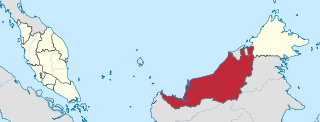
Sarawak is a state of Malaysia. The largest among the 13 states, with an area almost equal to that of Peninsular Malaysia, Sarawak is located in northwest Borneo Island, and is bordered by the Malaysian state of Sabah to the northeast, Kalimantan to the south, and Brunei in the north. The capital city, Kuching, is the largest city in Sarawak, the economic centre of the state, and the seat of the Sarawak state government. Other cities and towns in Sarawak include Miri, Sibu, and Bintulu. As of 2021, the population of Sarawak was estimated to be around 2.45 million. Sarawak has an equatorial climate with tropical rainforests and abundant animal and plant species. It has several prominent cave systems at Gunung Mulu National Park. Rajang River is the longest river in Malaysia; Bakun Dam, one of the largest dams in Southeast Asia, is located on one of its tributaries, the Balui River. Mount Murud is the highest point in the state. Sarawak is the only state of Malaysia with a Christian majority.
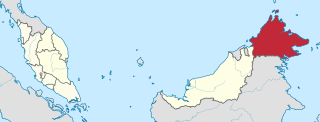
Sabah is a state of Malaysia located in northern Borneo, in the region of East Malaysia. Sabah borders the Malaysian state of Sarawak to the southwest and the North Kalimantan province of Indonesia to the south. The Federal Territory of Labuan is an island just off Sabah's west coast. Kota Kinabalu is the state capital city, the economic centre of the state, and the seat of the Sabah state government. Other major towns in Sabah include Sandakan and Tawau. The 2020 census recorded a population of 3,418,785 in the state. It has an equatorial climate with tropical rainforests, abundant with animal and plant species. The state has long mountain ranges on the west side which forms part of the Crocker Range National Park. Kinabatangan River, the second longest river in Malaysia runs through Sabah. The highest point of Sabah, Mount Kinabalu is also the highest point of Malaysia.

East Malaysia, or the Borneo States, also known as Malaysian Borneo, is the part of Malaysia on and near the island of Borneo, the world's third largest island. Near the coast of Sabah consists of a small archipelago called Labuan. East Malaysia lies to the east of Peninsular Malaysia, the part of the country on the Malay Peninsula. The two are separated by the South China Sea.

The geography of Malaysia includes both the physical and the human geography of Malaysia, a Southeast Asian country made up of two major landmasses separated by water—Peninsular Malaysia to the west and East Malaysia to the east—and numerous smaller islands that surround those landmasses. Peninsular Malaysia is on the southernmost part of the Malay Peninsula, south of Thailand, north of Singapore and east of the Indonesian island of Sumatra; East Malaysia comprises most of the northern part of Borneo island, and shares land borders with Brunei to the north and Indonesian Borneo to the south.

The bay cat, also known as the Bornean bay cat, is a small wild cat endemic to the island of Borneo that appears to be relatively rare compared to sympatric wild cats, based on the paucity of historical, as well as recent records. Since 2002, it has been listed as Endangered on the IUCN Red List because it is estimated that fewer than 2,500 mature individuals exist, and that the population declined in the past. The bay cat has been recorded as rare and seems to occur at relatively low density, even in pristine habitat.
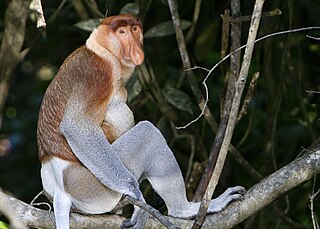
The proboscis monkey or long-nosed monkey is an arboreal Old World monkey with an unusually large nose, a reddish-brown skin color and a long tail. It is endemic to the southeast Asian island of Borneo and is found mostly in mangrove forests and on the coastal areas of the island.

The sun bear is a species in the family Ursidae occurring in the tropical forests of Southeast Asia. It is the smallest bear, standing nearly 70 centimetres at the shoulder and weighing 25–65 kilograms. It is stockily built, with large paws, strongly curved claws, small rounded ears and a short snout. The fur is generally jet-black, but can vary from grey to red. Sun bears get their name from the characteristic orange to cream coloured chest patch. Its unique morphology—inward-turned front feet, flattened chest, powerful forelimbs with large claws—suggests adaptations for climbing.

The Kinabatangan River is a river in Sandakan Division, in northeastern Sabah, Malaysia. It is the second longest river in Malaysia, with a length of 560 km (350 mi) from its headwaters in the mountains of southwest Sabah, to its outlet at the Sulu Sea, east of Sandakan. The area is known for its high-biodiversity habitats, including its limestone caves at Gomantong hill, dryland dipterocarp forests, riverine forest, freshwater swamp forest, oxbow lakes and salty mangrove swamps near the coast.
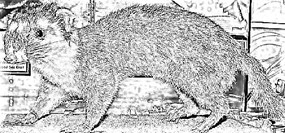
The Bornean ferret badger, also known as Everett's ferret badger or the Kinabalu ferret badger, is a small, nocturnal and omnivorous mammal that is endemic to the island of Borneo. It is a member of the family Mustelidae and is one of five species of the genus Melogale. It is listed as endangered on the IUCN Red List of Threatened Species due to its small distribution range, which includes Kinabalu National Park and Crocker Range National Park.

Malaysia is a country in Southeast Asia. The federal constitutional monarchy consists of thirteen states and three federal territories, separated by the South China Sea into two regions, Peninsular Malaysia and Borneo's East Malaysia. Peninsular Malaysia shares a land and maritime border with Thailand and maritime borders with Singapore, Vietnam, and Indonesia. East Malaysia shares land and maritime borders with Brunei and Indonesia and a maritime border with the Philippines and Vietnam. Kuala Lumpur is the national capital, largest city and the seat of the legislative branch of the federal government. The nearby planned capital of Putrajaya is the administrative capital, which represents the seat of both the executive branch and the judicial branch of the federal government. With a population of over 32 million, Malaysia is the world's 45th-most populous country. The southernmost point of continental Eurasia is in Tanjung Piai. In the tropics, Malaysia is one of 17 megadiverse countries, home to numerous endemic species.

The tailless fruit bat is a species of fruit bat in the family Pteropodidae.

The black-capped fruit bat is a species of megabat in the monotypic genus Chironax.

The long-tongued nectar bat, also known as the northern blossom bat, honey nectar bat, least blossom-bat, dagger-toothed long-nosed fruit bat, and lesser long-tongued fruit bat, is a species of megabat. M. minimus is one of the smallest species in the family Pteropodidae, with an average length of 60–85 mm. It has a reddish-brown colouring with relatively long hair compared to the other species. The hair on the abdomen is a lighter colour, and a dark brown stripe runs bilaterally down the top of the head and back.
Malaysian Wildlife Law consists of the regulation, protection, conservation and management of wildlife in Malaysia. The Constitution of Malaysia empowers those at the federal and the states level to make laws regarding wildlife resources. As such, eleven states in peninsular are managed under an act while Sabah enacted an enactment and Sarawak an ordinance.
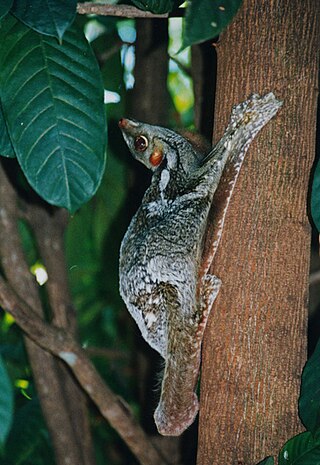
The Sunda flying lemur, also known as Sunda colugo, Malayan flying lemur and Malayan colugo, is a colugo species. It is native throughout Southeast Asia ranging from southern Myanmar, Thailand, southern Vietnam, Malaysia to Singapore and Indonesia.

The Malayan tailless leaf-nosed bat is a species of bat in the family Hipposideridae. It is a very small bat which has long and soft fur. The fur coloration is brown to blackish on the dorsal surface and ashy on the ventral surface. It can be distinguished from the other roundleaf bats by its small size and the absence of the tail. It is listed as vulnerable by the IUCN

The environment of Malaysia is the biotas and geologies that constitute the natural environment of Malaysia. Malaysia's ecology is megadiverse, with a biodiverse range of flora and fauna found in various ecoregions throughout the country. Tropical rainforests encompass between 59% to 70% of Malaysia's total land area, of which 11.6% is pristine. Malaysia has the world's fifth largest mangrove area, which totals over a half a million hectares.

The economy of Sarawak is the third-largest of the states of Malaysia, making up 9.5% of the Malaysian gross domestic product (GDP) in 2020. It has traditionally heavily depended on natural resource extraction and exports, including oil and gas, timber and palm oil. These commodities still produce a significant proportion of Sarawak's gross domestic product. Main trade partners of Sarawak are: Peninsular Malaysia, China, and Japan.
















